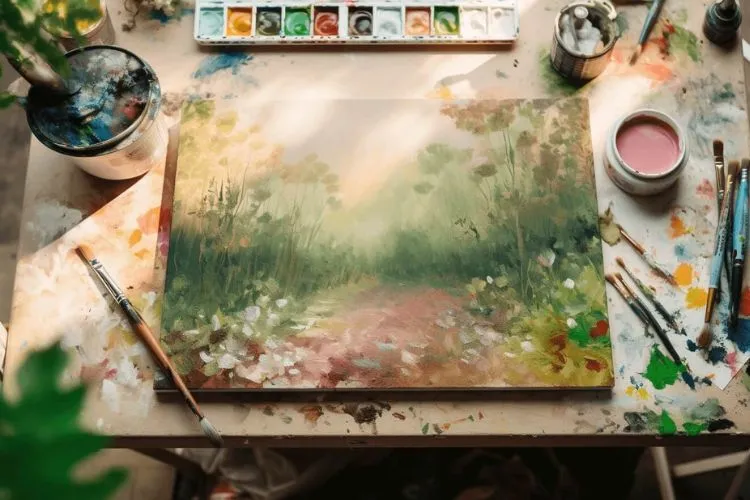Stepping into the world of painting opens up a spectrum of mediums, each with its unique qualities and challenges. Among these, acrylic paint stands out as a popular choice, especially for those just starting on their artistic journey.
This article dives deep into the world of acrylic paints, exploring their suitability for beginners, and offering tips for getting started.

Is Acrylic Paint Good for Beginners?
Yes, acrylic paint is good for beginners. It dries quickly, is water-soluble, easy to clean up, and versatile for various techniques and surfaces. Acrylics are forgiving, allowing for corrections and layered work.
They are less toxic and have minimal odor compared to oil paints, making them suitable for use in less ventilated spaces.
Additionally, acrylic paints are relatively inexpensive and available in a wide range of colors, which is ideal for beginners experimenting with their palette and style without a significant investment.
Composition and Characteristics
The fast-drying property of acrylic paint is a double-edged sword. It allows artists to quickly layer paint without long waits, making it ideal for artists who wish to work rapidly. However, it can also pose challenges, especially in techniques that require blending colors on the canvas.
Availability and Varieties
From heavy body paints that retain brush strokes to fluid ones that spread easily, acrylics cater to every artist’s need. The range of colors available is vast, making it easier for beginners to find exactly what they need without having to mix paints extensively.
Advantages of Acrylic Paint for Beginners

Ease of Use
Acrylic paint is notably user-friendly. Its water-based nature means it’s easy to clean up with just water, eliminating the need for harsh chemicals. Plus, its quick drying time allows for rapid correction of mistakes, a boon for beginners.
Versatility
Acrylics can be applied to a variety of surfaces like canvas, paper, wood, and even fabric. This versatility gives beginners the freedom to experiment without being constrained by medium-specific limitations.
Additionally, acrylics can be diluted to mimic watercolor effects or layered thickly like oils.
Quick Drying Time
The rapid drying time of acrylic paints is beneficial for beginners eager to see their progress quickly. It also facilitates the learning process, allowing for immediate experimentation with layering and textures.
Affordability
Compared to oils, acrylics are generally more affordable, making them an accessible option for beginners just starting to explore their interest in painting.
Tips for Beginning with Acrylic Paint
Getting started with acrylics involves more than just picking up a brush and paint. Here are a few essential tips to set you on the right path.
Understanding Your Materials
Familiarize yourself with the different types of acrylic paints and brushes available. Each has its own set of characteristics that can affect the outcome of your work. Knowing what each type of paint and brush does will help you make informed choices as you start.
Mastering Basic Techniques
Though experimentation is key, understanding basic painting techniques such as blending, dry brushing, and washing can significantly enhance your skill set.
These techniques form the foundation of acrylic painting, and mastering them will provide a solid base upon which to build your artistic abilities.
Mixing Colors
Experimenting with color mixing is crucial. It not only helps in achieving the exact shades you desire but also deepens your understanding of color theory, an essential component of painting.
Practice Regularly
As with any skill, regular practice is vital in improving your painting techniques. Dedicate time to paint, experiment, and learn from each piece you create.
Potential Challenges and How to Overcome Them
While acrylics offer numerous benefits for beginners, they also come with challenges that can seem daunting at first.

Fast Drying Time
The fast drying time of acrylics, though generally an advantage, can make blending colors on the canvas challenging. To circumvent this, use slow-drying mediums that extend the paint’s working time, allowing for smoother blends.
Thickness and Texture
Adjusting to the texture of acrylic paints, especially for those accustomed to watercolors or oils, can be a hurdle. Playing with various mediums can alter the viscosity of acrylic paints, making them easier to manipulate to your desired consistency.
You may also find useful: Is Acrylic Paint Easy to Blend? Master the Art of Acrylics
Resources for Learning Acrylic Painting
The internet abounds with tutorials and classes for acrylic painting. Additionally, many books cater specifically to beginners, offering structured lessons and exercises. Availing yourself of these resources can dramatically accelerate your learning curve.
Pro Tips
- Starting small can help build confidence.
- Keeping a mist spray handy will keep your paints from drying too quickly on your palette.
- Playing with different mediums can unlock new potentials in the acrylic paints, expanding your artistic capabilities.
- Creating a dedicated workspace encourages regular practice and can inspire creativity.
- Joining a community, whether online or in person, provides support, motivation, and valuable feedback.
Acrylic painting offers a world of possibilities. With patience and practice, beginners can unlock their creative potential and enjoy the vibrant, versatile medium that acrylics provide.
Frequently Asked Questions (FAQs)
What equipment do I need to start painting with acrylics?
A basic set includes acrylic paints, brushes, a palette, canvas or paper, and water for cleaning. Over time, you can expand your toolkit with mediums and different surfaces.
Can acrylic paints be used by children?
Yes, due to their non-toxic nature and easy clean-up, acrylics are suitable for children under supervision.
How do I prevent my acrylic paints from drying too fast?
Use a mist spray bottle to keep your palette moist, and consider mixing in slow-drying mediums with your paints.
What are the best surfaces to use with acrylic paints?
Canvas, wood, and specially prepared paper are among the most popular. However, acrylics are versatile enough to be used on many surfaces.
How do I clean up acrylic paint from brushes and surfaces?
Water and mild soap are generally sufficient for cleanup while the paint is wet. Once dry, acrylic paint is water-resistant, making removal more difficult.
Conclusion:
Acrylic paint’s unique properties make it an excellent choice for beginners. Its versatility, ease of use, and affordability provide a welcoming entry point into the world of painting.
By understanding the materials, mastering basic techniques, and regularly practicing, beginners can quickly improve their skills and enjoy the creative process.
Embrace mistakes as learning opportunities, and remember, the journey of art is about exploration and expression.

Meet Isabella Anderson, your acrylic painting mentor with over a decade of brush-wielding mastery. Dive into the colorful world of acrylics with her expert guidance, featured exclusively on ‘Acrylic Authority.’ Unleash your inner artist and explore the limitless possibilities of this versatile medium alongside a true acrylic aficionado.
